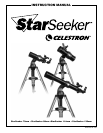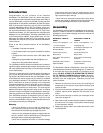
7
3. Tighten the thumbscrew to hold the eyepiece in place.
To remove the eyepiece, loosen the thumbscrew on the star
diagonal and slide the eyepiece out.
For StarSeeker 114mm and 130mm models:
1. Loosen the thumb screw on the eyepiece adapter at the
end of the focuser barrel and remove the protective dust
cap from the focuser barrel.
2. Slide the chrome portion of the low power 25mm eyepiece
into the eyepiece adapter.
3. Tighten the thumbscrew to hold the eyepiece in place.
To remove the eyepiece, loosen the thumbscrew on the eye-
piece barrel and slide the eyepiece out.
Eyepieces are commonly referred to by focal length and barrel
diameter. The focal length of each eyepiece is printed on the
eyepiece barrel. The longer the focal length (i.e., the larger
the number), the lower the eyepiece power or magnification;
and the shorter the focal length (i.e., the smaller the num-
ber), the higher the magnification. Generally, you will use
low-to-moderate power when viewing. For more information
on how to determine power, see the section on “Calculating
Magnification.”
Barrel diameter is the diameter of the barrel that slides into the
star diagonal or focuser. The StarSeeker uses eyepieces with
a standard 1-1/4" barrel diameter.
Focusing
To focus your telescope, simply turn either of the focus knobs
at the eyepiece end of the optical tube (see figures 2-3 and
2.4). Turn the focus knob until the image is sharp. Once sharp,
turn the knob towards you to focus on an object that is clos-
er than the one you are currently observing. Turn the knob
away from you to focus on a more distant object than the one
you are currently observing.
The Star Pointer Finderscope
The Star Pointer is the quickest and easiest way to point your
telescope exactly at a desired object in the sky. It’s like having
a laser pointer that you can shine directly onto the night sky.
The Star Pointer is a zero magnification pointing tool that uses
a coated glass window to superimpose the image of a small
red dot onto the night sky. While keeping both eyes open when
looking through the Star Pointer, simply move your telescope
until the red dot, seen through the Star Pointer, merges with
the object as seen with your unaided eye. The red dot is pro-
duced by a light-emitting diode (LED); it is not a laser beam
and will not damage the glass window or your eye. The Star
Pointer comes equipped with a variable brightness control, two
axes alignment control and mounting brackets. Before the Star
Pointer is ready to be used, it must be attached to the tele-
scope tube and properly aligned:
Star Pointer Installation
For StarSeeker 80mm and 130mm models:
1. Slide the Star Pointer bracket into the dovetail mounting
platform near the focuser assembly.
2. Orient the Star Pointer so that the sight tube is facing
towards the front of the tube.
3. Secure the Star Pointer bracket by tightening the thumb
screw on the mounting platform.
For StarSeeker 70mm and 114mm models:
1. Remove the nuts from the studs where the Star Pointer will
mount.
2. Mount the Star Pointer bracket by placing the bracket over
the studs protruding from the tube and tightening it down
with the supplied nuts. Orient the Star Pointer so that the
sight tube is facing towards the front of the tube.
Star Pointer Operation
The star pointer is powered by a long life 3-volt lithium battery
(#CR2032) located underneath the front portion of the Star
Pointer. Like all finderscopes, the Star Pointer must be properly
aligned with the main telescope before it can be used. This is
a simple process using the azimuth and altitude control knobs
located on the side and bottom of the Star Pointer. The align-
Figure 2-4.
Visual accessories for the StarSeeker 114mm & 130mm
Figure 2-3. Visual accessories for the StarSeeker 70mm & 80mm
Star diagonal
Eyepiece adapter
Focus knob
Star pointer
Eyepiece
Star pointer
Eyepiece
Focus
knob


















